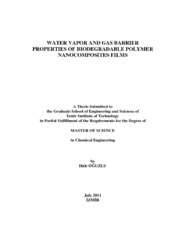Please use this identifier to cite or link to this item:
https://hdl.handle.net/11147/3124Full metadata record
| DC Field | Value | Language |
|---|---|---|
| dc.contributor.advisor | Tihminlioğlu, Funda | en |
| dc.contributor.author | Oğuzlu, Hale | - |
| dc.date.accessioned | 2014-07-22T13:50:54Z | |
| dc.date.available | 2014-07-22T13:50:54Z | |
| dc.date.issued | 2011 | en |
| dc.identifier.uri | http://hdl.handle.net/11147/3124 | |
| dc.description | Thesis (Master)--Izmir Institute of Technology, Chemical Engineering, Izmir, 2011 | en |
| dc.description | Includes bibliographical references (leaves: 99-106) | en |
| dc.description | Text in English; Abstract: Turkish and English | en |
| dc.description | xii, 177 leaves | en |
| dc.description.abstract | Polylactide nanocomposite (PLANC) films were prepared with solution intercalation method by introducing sonication as an alternative for conventional polymers. The effect of polymer clay interaction on PLANCs was investigated with respect to molecular weight of the polylactide, organic modifier presence and type by focusing on five major aspects: structural analysis, barrier, thermal, mechanical and rheological properties.According to structural analyses, the best level of dispersion was obtained in PL65-10A nanocomposites due to high molecular weight polylactide and organomodified nanoclay usage leading to better molecular interaction between the layered silicates and polymer chains. However, phase separated structure was observed in PLA composites prepared with unmodified clay as basal space between layered silicates were not sufficient enough for the penetrating of the polymer chains into the layers. Barrier and mechanical properties of the nanocomposites were improved up to critical clay content for each nanocomposite system. Thermal stability of the intercalated and exfoliated nanocomposites increased with the addition of the clay. Best improvements were obtained in PL65-10A nanocomposites in accordance with structural analyses. In dynamic mechanical analysis, glass transition temperatures and storage modulus of PLANCs increased with increasing of clay amount owing to reinforcement effect of the silicate layers. In rheological measurements, PLANCs showed solid-like behavior at lower shear rates due to the formation of a network percolating clay lamellae, besides PLANCs showed shear thinning behavior at higher shear rates leading to developments on the processability of nanocomposites. Consequently, intercalated and exfoliated PLANCs could be used as an eco-friendly promising alternative to conventional polymers for short-life applications such as food packaging and coating. | en |
| dc.language.iso | en | en_US |
| dc.publisher | Izmir Institute of Technology | en |
| dc.publisher | Izmir Institute of Technology | en_US |
| dc.rights | info:eu-repo/semantics/openAccess | en_US |
| dc.subject.lcsh | Polymers--Biodegradation | en |
| dc.subject.lcsh | Nanocomposites (Materials) | en |
| dc.title | Water vapor and gas barrier properties of biodegradable polymer nanocomposites films | en_US |
| dc.type | Master Thesis | en_US |
| dc.institutionauthor | Oğuzlu, Hale | - |
| dc.department | Thesis (Master)--İzmir Institute of Technology, Chemical Engineering | en_US |
| dc.relation.publicationcategory | Tez | en_US |
| item.languageiso639-1 | en | - |
| item.fulltext | With Fulltext | - |
| item.openairecristype | http://purl.org/coar/resource_type/c_18cf | - |
| item.openairetype | Master Thesis | - |
| item.grantfulltext | open | - |
| item.cerifentitytype | Publications | - |
| Appears in Collections: | Master Degree / Yüksek Lisans Tezleri | |
Files in This Item:
| File | Description | Size | Format | |
|---|---|---|---|---|
| T000929.pdf | MasterThesis | 4.01 MB | Adobe PDF |  View/Open |
CORE Recommender
Page view(s)
41,974
checked on Jul 22, 2024
Download(s)
194
checked on Jul 22, 2024
Google ScholarTM
Check
Items in GCRIS Repository are protected by copyright, with all rights reserved, unless otherwise indicated.